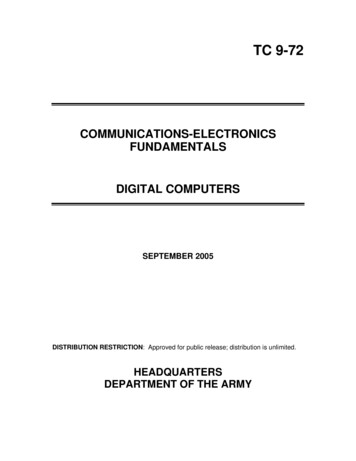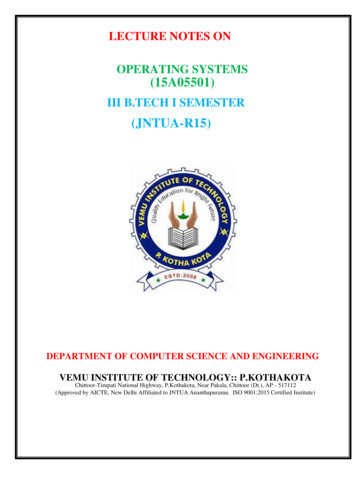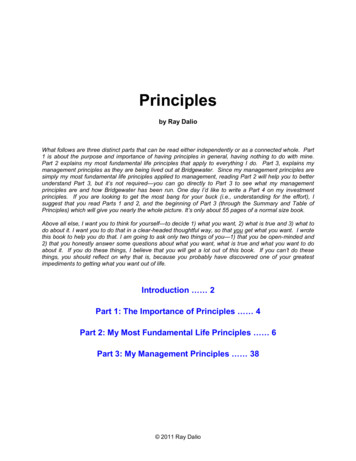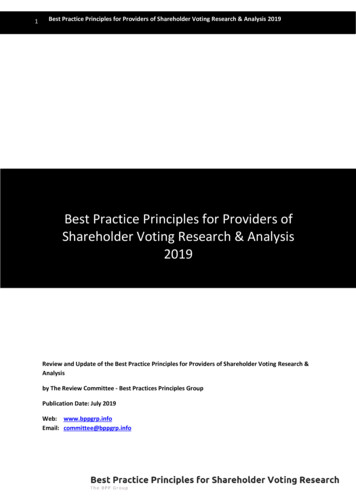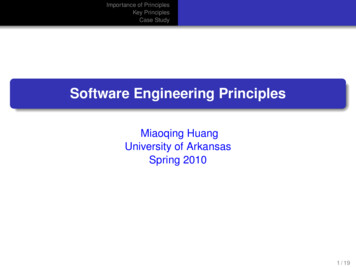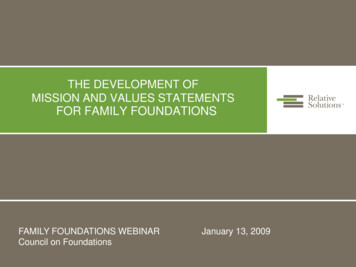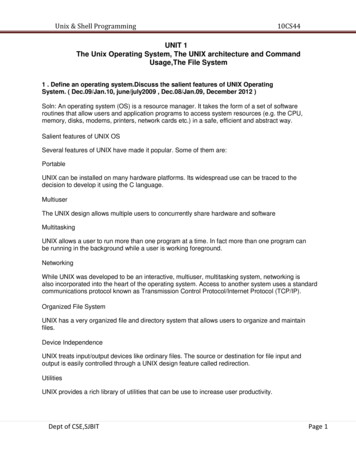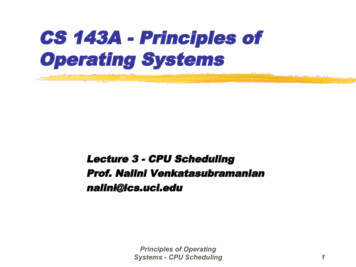
Transcription
CS 143A - Principles ofOperating SystemsLecture 3 - CPU SchedulingProf. Nalini Venkatasubramaniannalini@ics.uci.eduPrinciples of OperatingSystems - CPU Scheduling1
Outline Basic ConceptsScheduling ObjectivesLevels of SchedulingScheduling CriteriaScheduling Algorithms FCFS, Shortest Job First, Priority, Round Robin, Multilevel Multiple Processor Scheduling Real-time Scheduling Algorithm EvaluationPrinciples of OperatingSystems - CPU Scheduling2
CPU Burst DistributionPrinciples of OperatingSystems - CPU Scheduling3
Basic Concepts Maximum CPU utilizationobtained withmultiprogramming. CPU-I/O Burst Cycle Process execution consists of acycle of CPU execution and I/Owait.Principles of OperatingSystems - CPU Scheduling4
Scheduling Objectives Enforcement of fairness in allocating resources to processes Enforcement of priorities Make best use of available system resources Give preference to processes holding keyresources. Give preference to processes exhibiting goodbehavior. Degrade gracefully under heavy loads.Principles of OperatingSystems - CPU Scheduling5
Program Behavior Issues I/O boundedness short burst of CPU before blocking for I/O CPU boundedness extensive use of CPU before blocking for I/O Urgency and PrioritiesFrequency of preemptionProcess execution timeTime sharing amount of execution time process has already received.Principles of OperatingSystems - CPU Scheduling6
Levels of Scheduling High Level / Job Scheduling Selects jobs allowed to competefor CPU and other systemresources. Intermediate Level / MediumTerm Scheduling Selects which jobs to temporarilysuspend/resume to smoothfluctuations in system load. Low Level (CPU) Schedulingor Dispatching Selects the ready process that willbe assigned the CPU. Ready Queue contains PCBs ofprocesses.Principles of OperatingSystems - CPU Scheduling7
CPU Scheduler Selects from among the processes in memorythat are ready to execute, and allocates the CPUto one of them. Non-preemptive Scheduling Once CPU has been allocated to a process, the processkeeps the CPU until Process exits OR Process switches to waiting state Preemptive Scheduling Process can be interrupted and must release the CPU. Need to coordinate access to shared dataPrinciples of OperatingSystems - CPU Scheduling8
CPU Scheduling Decisions CPU scheduling decisions may take place whena process:1.2.3.4.switches from running state to waiting stateswitches from running state to ready stateswitches from waiting to readyterminates Scheduling under 1 and 4 is non-preemptive. All other scheduling is preemptive.Principles of OperatingSystems - CPU Scheduling9
CPU scheduling readyI/O oreventcompletionSchedulerdispatchI/O orevent waitwaitingPrinciples of OperatingSystems - CPU Scheduling10
Dispatcher OS dispatcher module gives control of the CPUto the process selected by the short-termscheduler. This involves: switching context switching to user mode jumping to the proper location in the user program to restart(continue) that program Dispatch Latency: time it takes for the dispatcher to stop one process and startanother running. Dispatcher must be fast.Principles of OperatingSystems - CPU Scheduling11
Scheduling Criteria CPU Utilization Keep the CPU and other resources as busy as possible Throughput # of processes that complete their execution per time unit. Turnaround time amount of time to execute a particular process from its entrytime.Principles of OperatingSystems - CPU Scheduling12
Scheduling Criteria (cont.) Waiting time amount of time a process has been waiting in the readyqueue. Response Time (in a time-sharing environment) amount of time it takes from when a request was submitteduntil the first response is produced, NOT output.Principles of OperatingSystems - CPU Scheduling13
Optimization Criteria Optimize overall system Max CPU Utilization Max Throughput Optimize individual processes’ performance Min Turnaround time Min Waiting time Min Response timePrinciples of OperatingSystems - CPU Scheduling14
First Come First Serve (FCFS)Scheduling Policy: Process that requests the CPU FIRST is allocatedthe CPU FIRST. FCFS is a non-preemptive scheduling algorithm. Implementation - using FIFO queues incoming process is added to the tail of the queue. Process selected for execution is taken from head of queue. Performance metric - Average waiting time in queue. Gantt Charts are used to visualize schedules.Principles of OperatingSystems - CPU Scheduling15
First-Come,First-Served(FCFS) Scheduling Example Suppose the arrival orderfor the processes is P1, P2, P3 Waiting time P1 0; P2 24; P3 27;Gantt Chart for ScheduleP10P224P327 Average waiting time30 (0 24 27)/3 17Principles of OperatingSystems - CPU Scheduling16
FCFS Scheduling (cont.) Suppose the arrival order forthe processes is Example P2, P3, P1 Waiting time P1 6; P2 0; P3 3; Average waiting time (6 0 3)/3 3 , better. Convoy Effect:Gantt Chart for ScheduleP20P33P1630Principles of OperatingSystems - CPU Scheduling short process behind longprocess, e.g. 1 CPU boundprocess, many I/O boundprocesses.17
Shortest-Job-First (SJF) Scheduling Associate with each process the length of its next CPU burst.Use these lengths to schedule the process with the shortesttime. Two Schemes: Scheme 1: Non-preemptive Once CPU is given to the process it cannot be preempted until itcompletes its CPU burst. Scheme 2: Preemptive If a new CPU process arrives with CPU burst length less thanremaining time of current executing process, preempt. Also calledShortest-Remaining-Time-First (SRTF). SJF is optimal - gives minimum average waiting time for a given setof processes.Principles of OperatingSystems - CPU Scheduling18
Non-Preemptive SJFScheduling ExampleGantt Chart for ScheduleP10P37P28Average waiting time (0 6 3 7)/4 4P41216Principles of OperatingSystems - CPU Scheduling19
Preemptive SJF Scheduling(SRTF) ExampleGantt Chart for ScheduleP10P22P3 P245P47P11116Average waiting time (9 1 0 2)/4 3Principles of OperatingSystems - CPU Scheduling20
Determining Length of NextCPU Burst One can only estimate the length of burst. Halting problem: cannot (in general) determine if a program will runforever on some input or complete in finite time Estimate next CPU burst by anexponentially-weighted moving average overprevious ones: tn actual length of nth burst τn 1 predicted value for the next CPU burst α weight, 0 α 1 Define τn 1 α tn (1 - α) τnPrinciples of OperatingSystems - CPU Scheduling21
Prediction of the length of thenext CPU burst22
Exponential Averaging(cont.) α 0 τn 1 τn; Recent history does not count α 1 τn 1 tn; Only the actual last CPU burst counts. Similarly, expanding the formula: τn 1 αtn (1-α) αtn-1 (1-α) j αtn-j (1-α) (n 1)τ0 Each successive term has less weight than its predecessor.Principles of OperatingSystems - CPU Scheduling23
Priority Scheduling A priority value (integer) is associated with eachprocess. Can be based on Cost to userImportance to userAging%CPU time used in last X hours. CPU is allocated to process with the highestpriority. Preemptive Non-preemptivePrinciples of OperatingSystems - CPU Scheduling24
Priority Scheduling (cont.) SJF is a priority scheme where the priority is thepredicted next CPU burst time. Higher priority number lower priority E.g. priority 0 is higher priority than priority 1 Problem Starvation!! - Low priority processes may never execute. Solution Aging - as time progresses increase the priority of theprocess.Principles of OperatingSystems - CPU Scheduling25
Round Robin (RR) Each process gets a small unit of CPU time Time quantum usually 10-100 milliseconds. After this time has elapsed, the process is preempted, moved to the end of theready queue, and the process at the head of the ready queue is allocated theCPU. n processes, time quantum q Each process gets 1/n CPU time in chunks of at most q at a time. No process waits more than (n-1)q time units. Performance considerations:– Time slice q too large – FIFO (FCFS) behavior– Time slice q too small - Overhead of context switch is too expensive.– Heuristic - 70-80% of jobs block within time slicePrinciples of OperatingSystems - CPU Scheduling26
Round Robin Example Time Quantum 20Gantt Chart for ScheduleP1020P237P357P4P177P3P4P1P397 117 121 134P3154 162Typically, higher average turnaround time than SRTF, but better response timePrinciples of OperatingSystems - CPU Scheduling27
Multilevel Queue Ready Queue partitioned into separate queues Example: system processes, foreground (interactive), background(batch), student grades Each queue has its own scheduling algorithm Example: foreground (RR), background (FCFS) Processes assigned to one queue permanently. Scheduling must be done between the queues Fixed priority - serve all from foreground, then from background.Possibility of starvation. Time slice - Each queue gets some CPU time that it schedules - e.g.80% foreground (RR), 20% background (FCFS)Principles of OperatingSystems - CPU Scheduling28
Multilevel QueuesPrinciples of OperatingSystems - CPU Scheduling29
Multilevel Feedback Queue Multilevel Queue with priorities A process can move between the queues. Aging can be implemented this way. Parameters for a multilevel feedback queuescheduler: number of queues.scheduling algorithm for each queue.method used to determine when to upgrade a process.method used to determine when to demote a process.method used to determine which queue a process will enterwhen that process needs service.Principles of OperatingSystems - CPU Scheduling30
Multilevel Feedback Queues Example: Three Queues Q0 - time quantum 8 milliseconds (FCFS) Q1 - time quantum 16 milliseconds (FCFS) Q2 - FCFS Scheduling New job enters Q0 - When it gains CPU, it receives 8milliseconds. If job does not finish, move it to Q1. At Q1, when job gains CPU, it receives 16 more milliseconds.If job does not complete, it is preempted and moved to Q2.Principles of OperatingSystems - CPU Scheduling31
Multilevel Feedback QueuesPrinciples of OperatingSystems - CPU Scheduling32
Multiple-Processor Scheduling CPU scheduling becomes more complex when multipleCPUs are available. Have one ready queue accessed by each CPU. Self scheduled - each CPU dispatches a job from ready Q Manager-worker - one CPU schedules the other CPUs Homogeneous processors within multiprocessor. Permits Load Sharing Asymmetric multiprocessing only 1 CPU runs kernel, others run user programsPrinciples of OperatingSystems - CPU Scheduling33
Real-Time Scheduling Hard Real-time Computing required to complete a critical task within a guaranteedamount of time. Soft Real-time Computing requires that critical processes receive priority over lessimportant ones. Types of real-time Schedulers Periodic Schedulers - Fixed Arrival RateDemand-Driven Schedulers - Variable Arrival RateDeadline Schedulers - Priority determined by deadline Principles of OperatingSystems - CPU Scheduling34
Issues in Real-timeScheduling Dispatch Latency Problem - Need to keep dispatch latency small, OS may enforceprocess to wait for system call or I/O to complete. Solution - Make system calls preemptible, determine safe criteria suchthat kernel can be interrupted. Priority Inversion and Inheritance Problem: Priority Inversion– Higher Priority Process P0 needs kernel resource currently being used byanother lower priority process P1.– P0 must wait for P1, but P1 isn’t getting scheduled in CPU! Solution: Priority Inheritance– Low priority process now inherits high priority until it has completed use ofthe resource in question.Principles of OperatingSystems - CPU Scheduling35
Real-time Scheduling Dispatch LatencyPrinciples of OperatingSystems - CPU Scheduling36
Scheduling AlgorithmEvaluation Deterministic Modeling Takes a particular predetermined workload and defines theperformance of each algorithm for that workload. Too specific, requires exact knowledge to be useful. Queuing Models and Queuing Theory Use distributions of CPU and I/O bursts. Knowing arrival andservice rates - can compute utilization, average queue length,average wait time, etc Little’s formula: n λ W– n is the average queue length, λ is the avg. arrival rate and W isthe avg. waiting time in queue. Other techniques: Simulations, ImplementationPrinciples of OperatingSystems - CPU Scheduling37
Systems - CPU Scheduling 8 CPU Scheduler Selects from among the processes in memory that are ready to execute, and allocates the CPU to one of them. Non-preemptive Scheduling Once CPU has been allocated to a process, the process keeps the CPU until Process exits OR Process switches to waiting state Preemptive Scheduling

